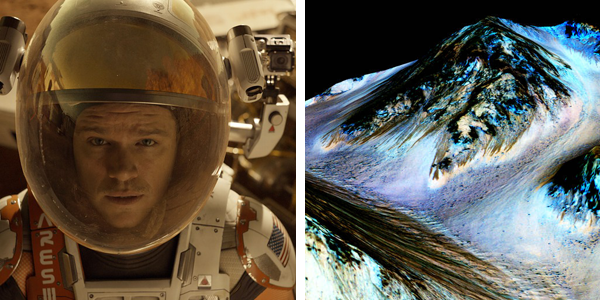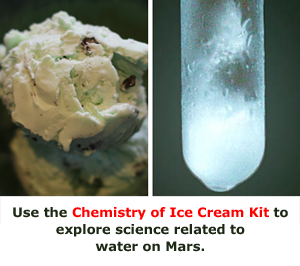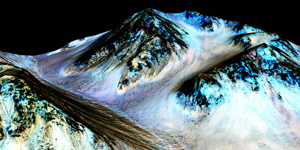Water on Mars—From Sci-Fi to Space Science
The action in a popular sci-fi movie explodes when an astronaut stranded on Mars attempts to create water to irrigate his plants. Real-world space science, on the other hand, has been buzzing with new findings about water on Mars. The dry planet isn't completely dry after all.

The big screen adaptation of Andy Weir's 2011 novel, The Martian, has been a hit with fans and critics in part because the story of Mark Watney is packed with believable and plausible science and engineering. Watney is stranded on Mars when a Martian storm forces the crew of the Ares III to abandon the planet. Watney, presumed dead, is left behind.
Recording his thought processes and actions as he assesses his current challenges and brainstorms solutions, Watney, a botanist with plenty of attitude and a bevy of engineering and chemistry skills, calls upon his science know-how as he struggles to find ways to survive.
Plant Science on Mars
While initial counts indicate he has food supply to last more than a year, Watney knows he will need more than that. He comes up with a plan to use human waste as fertilizer for plants he hopes to grow from parts of potatoes, but finding a sustainable source of water for the plants on the dry planet is a problem.
"I don't want to come off as arrogant here, but I'm the best botanist on the planet." ~Mark Watney, The Martian
His solution is to make water by burning rocket fuel. A miscalculation leads to an explosion, but when he tries again (suited up appropriately!), his plan works. (If you are curious about the ways in which the movie differs from the book in terms of this "make water" science, see this recount of parts of the story (and science) that were cut from the movie.)
The Martian has been widely discussed (and acclaimed) for the science Watney employs in solving the problems he faces on Mars. For viewers of all ages, the MacGyver-like science-based solutions Watney comes up with are impressive and inspiring. As the sci-fi story shows, real-world application of science, technology, engineering, and math (STEM) can make a big difference in what happens—even on Mars!
Watney's approach to sourcing water is a great example of science-based ingenuity. If the story was written again today, however, his search for water might have taken a different direction. Rather than burning rocket fuel, he might have focused on extracting (and desalinating) frozen water from below the surface of Mars.
NASA Confirms Water on Mars
Perfectly-timed to capture the attention of moviegoers and the science community alike, space science news has been buzzing with recent findings that indicate not only that there is water on Mars but that billions of years ago there were large bodies of waters on Mars.
Images captured by the Mars Reconnaissance Orbiter (MRO) show "streaks" that appear to run down the sides of a Martian mountain when temperatures rise. These streaks disappear when temperatures are lower, a finding in keeping with water flowing as it thaws in warmer seasons and then stopping as it freezes during colder times of the year.
Even after images from MRO raised optimistic speculation that the streaks that appear and disappear signal the presence of liquid flowing at the surface, scientists were cautious.
"If I want water, I'll have to make it from scratch. Fortunately, I know the recipe: Take hydrogen. Add oxygen. Burn." ~Mark Watney, The Martian
MRO Spectrometers were used to analyze light bouncing off the surface of Mars. Spectral analysis of the streaks led to the conclusion that the streaks are composed of hydrated salts—streaks caused by salty water. NASA scientists have referred to the water on Mars as "liquid brine."
The salty composition of the water is especially important in understanding how the water on Mars is seeming to thaw and flow on a planet with temperatures that are often much lower than the freezing point of water. According to NASA reports, the streaks that are now viewed as indicators of "flowing water" on Mars appear when temperatures rise above minus 10 degrees Fahrenheit (minus 23 Celsius).
How is it that water can flow at these temperatures?
Ice Cream Science
The science behind making ice cream and findings of water on Mars may seem to have nothing at all in common, until you add a bit of salt. When making ice cream, salt is commonly used as part of the process because salt lowers the freezing point of water. Families can explore this process in a hands-on science activity making ice cream in a baggy.
Students can experiment further in the Chemistry of Ice-Cream Making: Lowering the Freezing Point of Water science project.
In this food science exploration, students put the relationship between salt and the freezing point of water to the test. How much difference does salt make? How much salt does it take? To answer that question, students examine molality, the van't Hoff factor of the solute, and the molal freezing-point-depression constant of the solvent. (A convenient kit for this science fair project is available.)
After doing this chemistry experiment, students will know how to make ice cream and, should they ever get stranded on Mars, they will have a salty, inside look at the water that may be available on a seemingly dry planet. The Chemistry of Ice Cream project may help students see, firsthand, how the presence of salt in the soil on Mars is related to the water on Mars. Plus, on a snowy winter day on Earth, the project will make spreading salt on icy roads make sense, in a Martian-water sort of way.
Making Connections
For additional hands-on science projects and activities related to salt, water, freezing points, and hydrated soil, see:
- Ice Cream Science
- Supercooling Water and Snap Freezing
- Melting Ice
- Investigating the 'Mpemba Effect': Can Hot Water Freeze Faster than Cold Water?
- Soil Color and Moisture
For more survivalist-related science and popular culture tie-ins, see:
- Surviving a Zombie Apocalypse
- LEGO Movie Makes Engineering Awesome
- A Dolphin Tail and Prosthetics Engineering
Think the book is always better than the movie? The Martian is a great movie, but you will find even more fun and inspiring science in the book: The Martian.
Categories:
You Might Also Enjoy These Related Posts:
- Star Wars Projects for May the 4th Be With You Science
- Mario Day STEM — Bring Mario World to Life with Hands-on Science and Engineering Activities!
- When Your Science Project Opens a Wormhole--Alternate Universe Movie for Science Class
- Science with Fidget Spinners
- Water on Mars—From Sci-Fi to Space Science
- A Dolphin Tail and Prosthetics Engineering
- LEGO Movie Makes Engineering Awesome
- Iron Man and Fiber Optics—Technology at the Speed of Light











